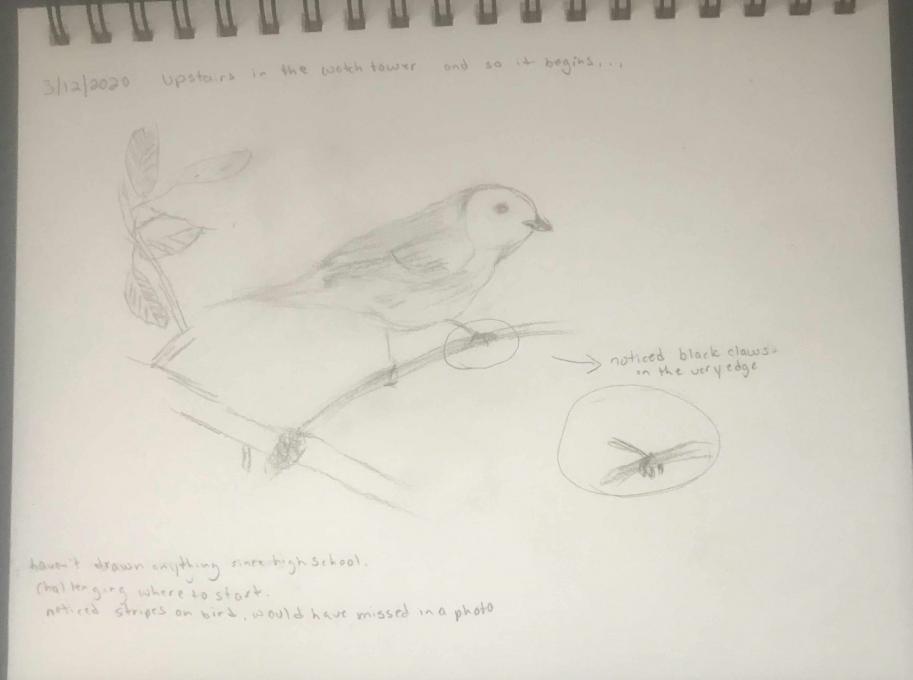The Cornell Lab Bird Academy › Discussion Groups › Nature Journaling and Field Sketching › Jump Right in!
-
My proportions were a bit off - I made him a bit slimmer than he actually is, but it was fun to get back into drawing. I found the ability to see small details for a long time was great, but it would also be nice to incorporate notes about behavior, interactions, etc. It was also great to notice the leaves, and the different color variations of the bird.

-

-
My sketch came out better than I expected, I'm happy with it and it'll b interesting to see what it will be like later. Easier part of the sketch for me was filling in the sketch/shading of the bird, the hard part was getting an outline with proportions! Details of the wings are hard as well. I probably wouldn't have paid much attention to the birds feet/nails in such detail and definitely wouldn't have noticed the type of leaves or the lichen on the branches. I think noticing the little details can make a difference in nature journaling as it's these details that can give you a better idea of the subject you're looking at and its behaviors. Any additional details gives more information to the big picture.

-
The color matching was difficult. I noticed movement more through drawing.
-
 1. I got this new paint and brush set and I’m still getting used to it. I overloaded my brush a few times and got my sleeve in some paint so there are some splotches. 2. I think I had to look a lot more carefully at the colors in order to paint it.
1. I got this new paint and brush set and I’m still getting used to it. I overloaded my brush a few times and got my sleeve in some paint so there are some splotches. 2. I think I had to look a lot more carefully at the colors in order to paint it. -
I, too have the watercolor packet that you have in your picture. I find it very portable for day trips. Your color matches look good!
-
-
 1. Working with watercolor is hard for me. I always end up using too much water and my colors all bleed together.
2. Because I was trying to draw it, I counted the number of black and yellow stripes in the wing, the softness of the feathers around the shoulder, and the curve of the fingers around the claw. I didn't capture all of those details accurately, but I looked at it much more closely than I would have otherwise.
1. Working with watercolor is hard for me. I always end up using too much water and my colors all bleed together.
2. Because I was trying to draw it, I counted the number of black and yellow stripes in the wing, the softness of the feathers around the shoulder, and the curve of the fingers around the claw. I didn't capture all of those details accurately, but I looked at it much more closely than I would have otherwise. -
1. I felt terrified. Where do you start! I was also worried it would not turn out well and I would lose confidence in my abilities. Reflecting afterwards – I am my own worst critic, it turned out better than I thought it would. I am still nervous to post it, but thats why we are all here right! Overall I am excited to see what I improve on when this course is finished. The body outline seemed easy. I enjoyed the lichen patterns too. I felt the texture of the feathers where hard to capture. 2.I really tried to pay attention to what feathers where black vs yellow in the wings. I was thoughtful on my lichen, trying to distinguish the different types. I think in journaling in real life it will be hard to capture all the colors, patterns, and details of the bird. Warblers are not in one spot for very long! I will have to learn to take a good look and try to remember as much as can.

-
 I felt not very confident going in to this, but the results turned out pretty well, although I am more accustomed to drawing larger birds. A detail that I Would have missed would most likely be the feather detail. This would make a big difference.
I felt not very confident going in to this, but the results turned out pretty well, although I am more accustomed to drawing larger birds. A detail that I Would have missed would most likely be the feather detail. This would make a big difference. -

-
I use to draw the bird only graphite pen HB Staedler, is correct?
-

-
I love your detail on the branch and leaves!
-
-
As I began, I felt the hesitation that comes with the pressure to "perform" - even though this is course is just for me, I still find myself motivated by a need to achieve. But as I began getting lost in the texture of the branches, the shape of the leaves, the posture of the warbler, the need to be "good" was overcome by an enjoyment of the detail of nature. A look at the photograph reveals a striking yellow bird against a background of green. But with a pencil in hand, trying to recreate the image, I saw all the life that is present in the image. It is not just a branch, but a symbiotic relationship with at least four forms of lichen, not just a yellow bird, but a bird with yellow, grey, deep black, rust orange. He (she?) is not just sitting on a branch, but poised, watchful, alive. In the end, I didn't add color because I like how the rough sketch captures the movement and texture and shape. I feel as though I now know a bit about yellow warblers, and will more easily identify one in the future - a knowledge I wouldn't have just from looking at the photo.

-
nice to be able to capture this image without concern that bird would move! able to check out size of body compared to head. Tried to add color but my paper wasn't good for wet media if I tried to add more than one layer. Ok though because I chose to use a sketchpad I had at home . I noticed how many colors are on this bird that I would have missed if drawing it in nature. When I draw it next I will be able to add those colors.
-

-
Inspired by the journal survey video, I was trying to think about birds' shapes, about how to fill the page, and about how to verbally note the experience in addition to images. Because I wasn't in the field, I borrowed my text from the Cornell Lab overview of the yellow warbler, in addition to writing in my ideas about drawing vs. photographs (for me it's in the timing of detail: drawing invites contemplation of details in the moment, whereas a looking at a photograph, not necessarily taking a photograph, invites contemplation of detail after the encounter has ended). Thinking about shapes actually really did make the drawing easier, but I really struggled with finding a full-page style that I liked. When I first started this course I was all about learning more about drawing anatomy, but now I'm excited to think about developing a visual thinking style that includes both text and image. I definitely don't think I would have paid attention to the moss on the twig if I weren't trying to draw the photograph, and I also don't think I would have noticed how the head of the warbler isn't mottled with other colors. I think it'll definitely make a difference when journaling, but I'm unsure how I'll react to missing detail when confronted with moving and living beings who can remove themselves from the portrait sitting at any moment.

-
Hi, I love the term (and idea of) “a visual thinking style!” Thanks for sharing your process and progress and I commend you for your overall and multi-faceted approach you are taking to this “sketching course.” I too sense opportunities for personal engagement and creating a personalized record that may be shareable, but most importantly represents the full experience of observation, study and appreciation of Nature.
-
@Tom Hi, Tom, thanks for your thoughts!
-
-
I felt overwhelmed - there is so much to the bird, how can I draw it all? The overall bird outline came easily, although the proportions need some work. I found it challenging to draw the leaves well, and impossible to reproduce the glossy, leathery texture of the leaves. I avoided entirely the challenge of expressing the lichen on the branch.

-

-
It was difficult to get the proportions right—how long the legs should be, how long the tail sticks out relative to the rest of the bird. I thought proportions would come more naturally, but turns out it's hard to get them right! I did enjoy the process of drawing the bird, and felt like I noticed the streaks on the chest in greater detail than I would have had I simply taken a photo and moved on. I also noticed that right near the bird's nape (back of neck, yes?) the yellow hue turns more olive-yellow as opposed to the bright lemon-yellow on the birds face and flanks. This would definitely make a difference in nature journaling, because otherwise these details would be missed.
-
Did not use color on this, but here it is. I am not in love with the result, but I am trying not to judge myself and have forced myself to share! I found myself noticing the details on leaves and the bark as well as the slight tones of grey around the bird's head. I struggled to bring the image to life the way I would like, and evoke a sense of the "moment." If I was not asked the draw the photo, I probably would not have noticed the way the leg positioning changes the overall shape of the bird.

-
It was a lot harder to draw than I imagined but I enjoyed doing it immensely -- I was completely absorbed in the details, even if I didn't do a very good job of portraying them. I wouldn't say anything came easily. I have not tried drawing anything like that in nearly 40 years. I have been taking photos of birds for some time, and this is very different. I am a bird watcher and educator, so I am used to spending time observing bird form and behaviour through binoculars or scope and identifying and interepreting them for groups, but this is a very different experience, lending much more attention to the finer details of the form and physical features rather than behavior. (Now I see the bill is more like a duck's -- a Duck-billed Warbler!)
-

-
- Well, the subject didn't fly away - that's good! The photograph gave me time to observe details about the bird I probably wouldn't have noticed in the field. In the field, birds are tiny, quick and tend to hide behind branches, leaves and in the underbrush, making observation difficult. I didn't use watercolor for this first sketch (computer is upstairs, drawing equipment is downstairs). I will print out the warbler picture to work on for my next sketch. I think that next time, I will try to compose the picture better.

-
I found this difficult. I didn't even try to add color. After comparing what I did to the others, I feel like I'm just not very good. It's frustrating because I have taken drawing lessons. I don't know how it would be to draw warblers from life, as they are always moving.
-
 Typically, I draw from photos instead of from real life, which is much harder. I often take photos, just so that I can zoom into what I see, and with birds, have a better chance of identification. While working on this exercise, I found myself more attentive, interestingly enough, to the texture of the feathers and leaves -- as well as the variations of color.
Typically, I draw from photos instead of from real life, which is much harder. I often take photos, just so that I can zoom into what I see, and with birds, have a better chance of identification. While working on this exercise, I found myself more attentive, interestingly enough, to the texture of the feathers and leaves -- as well as the variations of color. -

Read More:
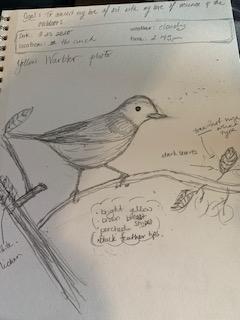
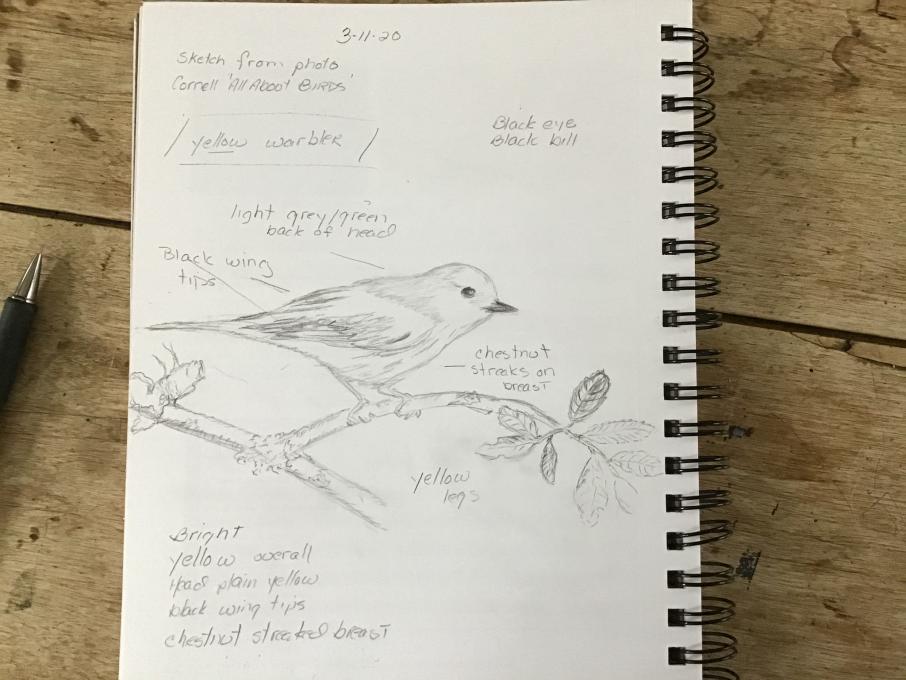
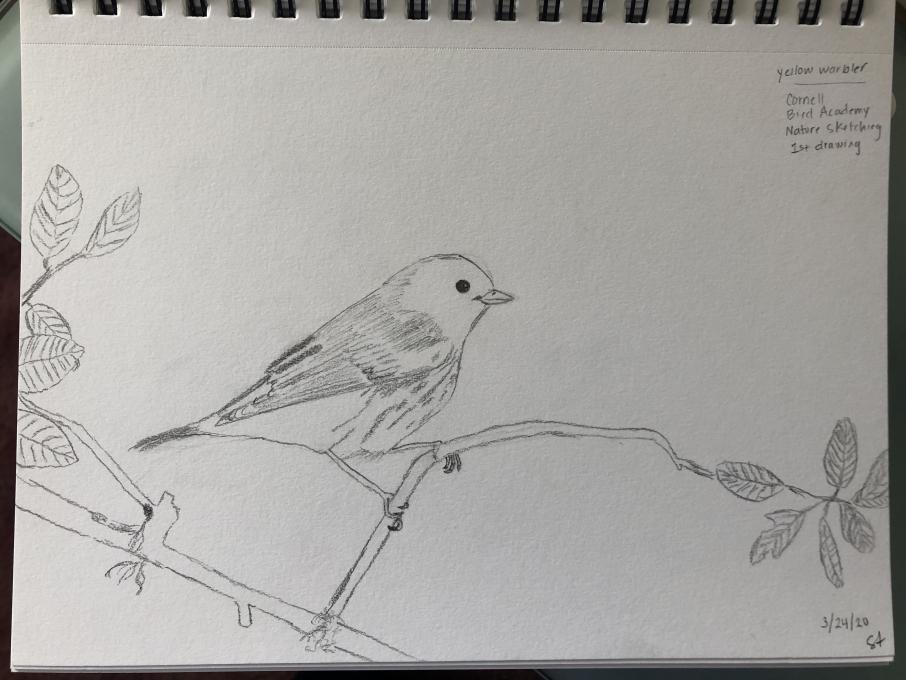
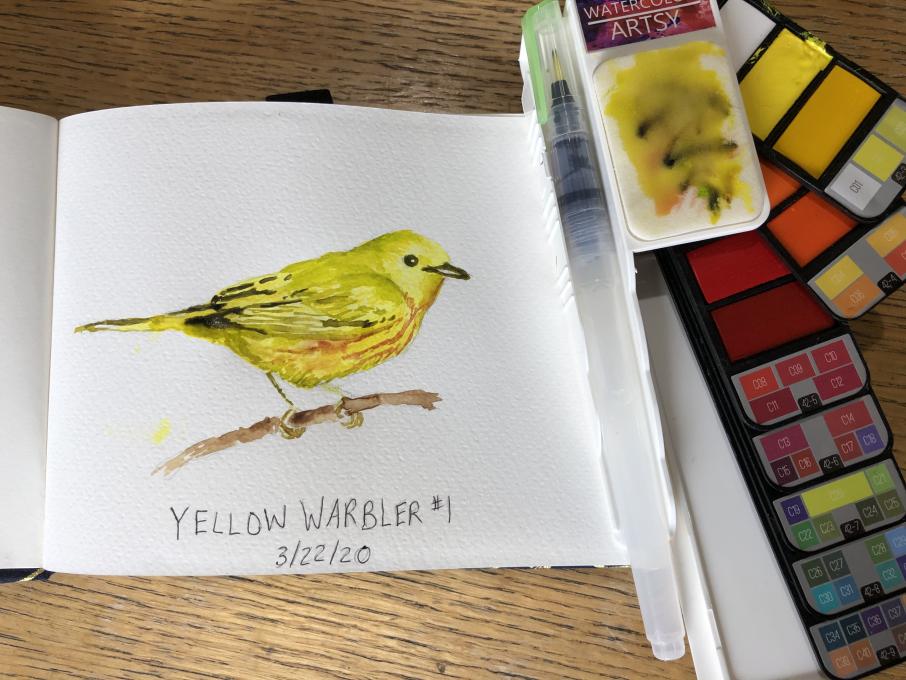 1. I got this new paint and brush set and I’m still getting used to it. I overloaded my brush a few times and got my sleeve in some paint so there are some splotches. 2. I think I had to look a lot more carefully at the colors in order to paint it.
1. I got this new paint and brush set and I’m still getting used to it. I overloaded my brush a few times and got my sleeve in some paint so there are some splotches. 2. I think I had to look a lot more carefully at the colors in order to paint it. 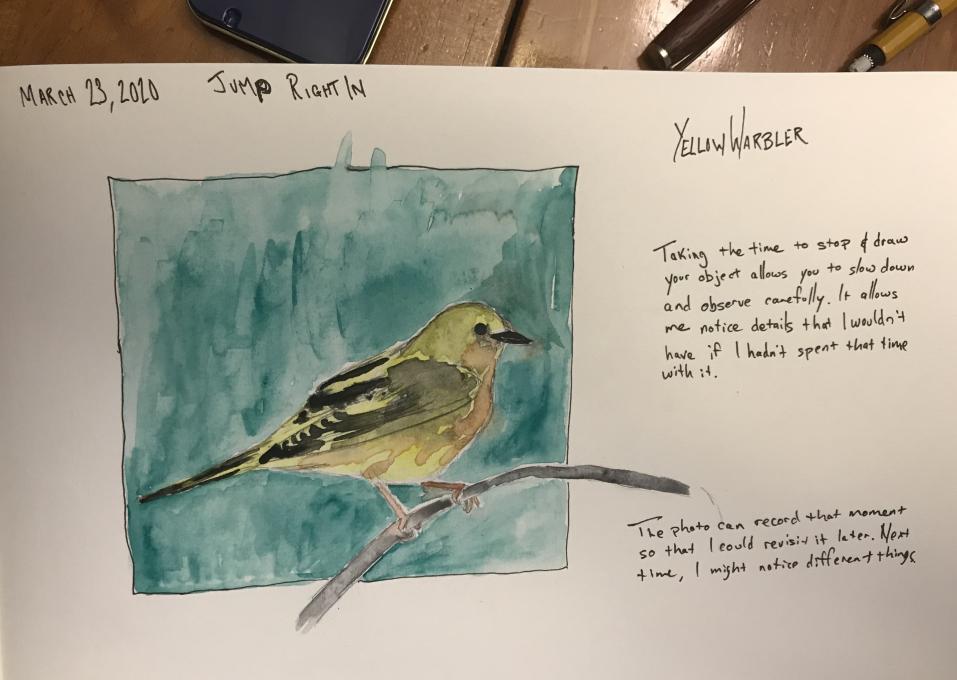 1. Working with watercolor is hard for me. I always end up using too much water and my colors all bleed together.
2. Because I was trying to draw it, I counted the number of black and yellow stripes in the wing, the softness of the feathers around the shoulder, and the curve of the fingers around the claw. I didn't capture all of those details accurately, but I looked at it much more closely than I would have otherwise.
1. Working with watercolor is hard for me. I always end up using too much water and my colors all bleed together.
2. Because I was trying to draw it, I counted the number of black and yellow stripes in the wing, the softness of the feathers around the shoulder, and the curve of the fingers around the claw. I didn't capture all of those details accurately, but I looked at it much more closely than I would have otherwise. 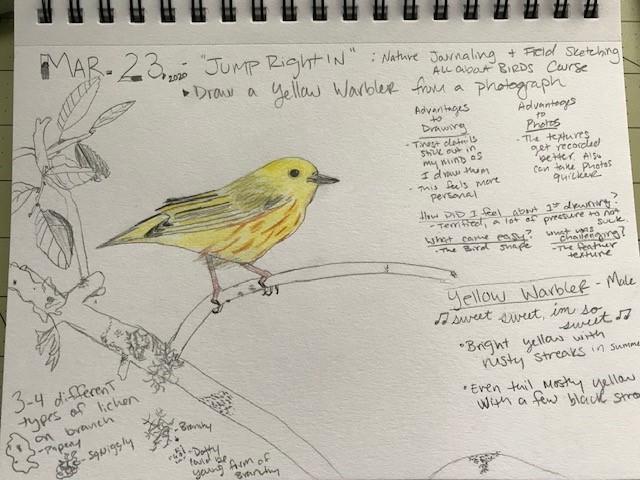
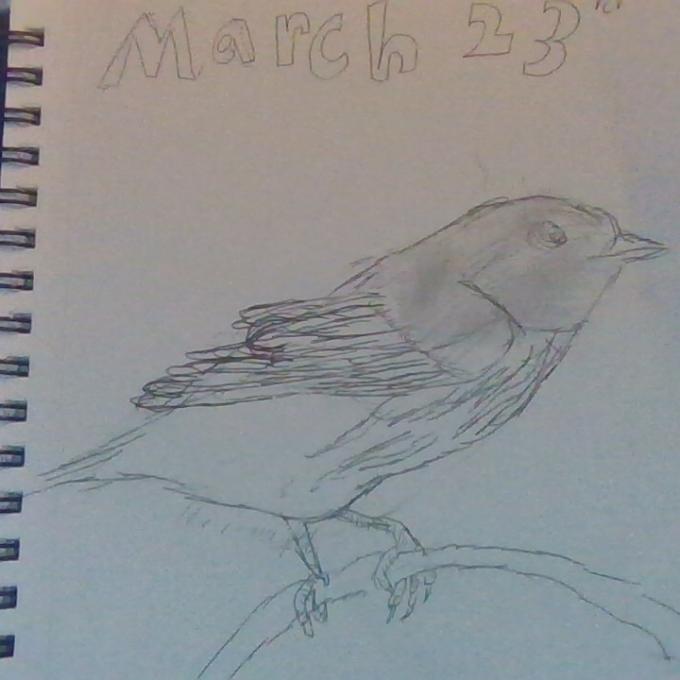 I felt not very confident going in to this, but the results turned out pretty well, although I am more accustomed to drawing larger birds. A detail that I Would have missed would most likely be the feather detail. This would make a big difference.
I felt not very confident going in to this, but the results turned out pretty well, although I am more accustomed to drawing larger birds. A detail that I Would have missed would most likely be the feather detail. This would make a big difference. 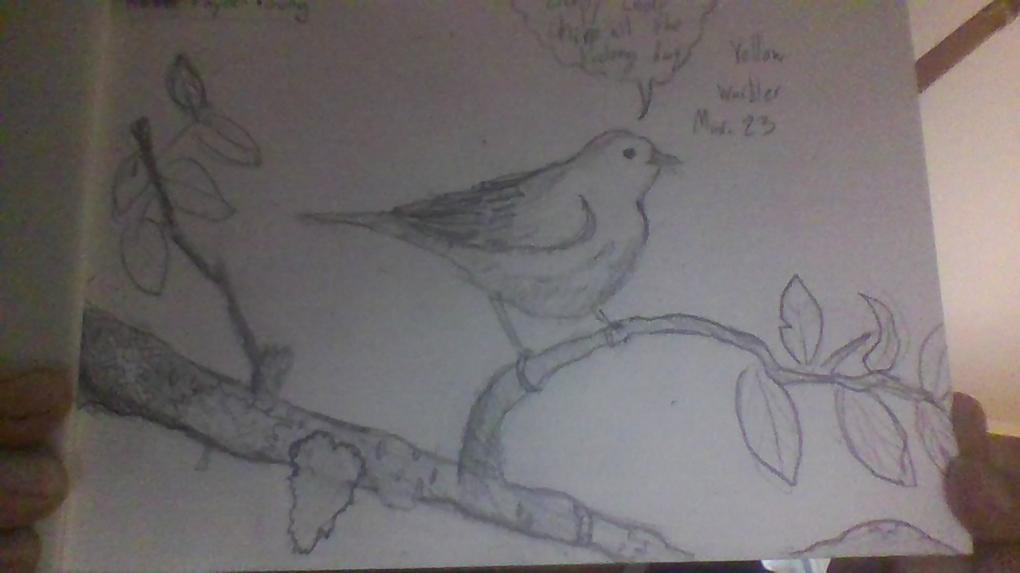
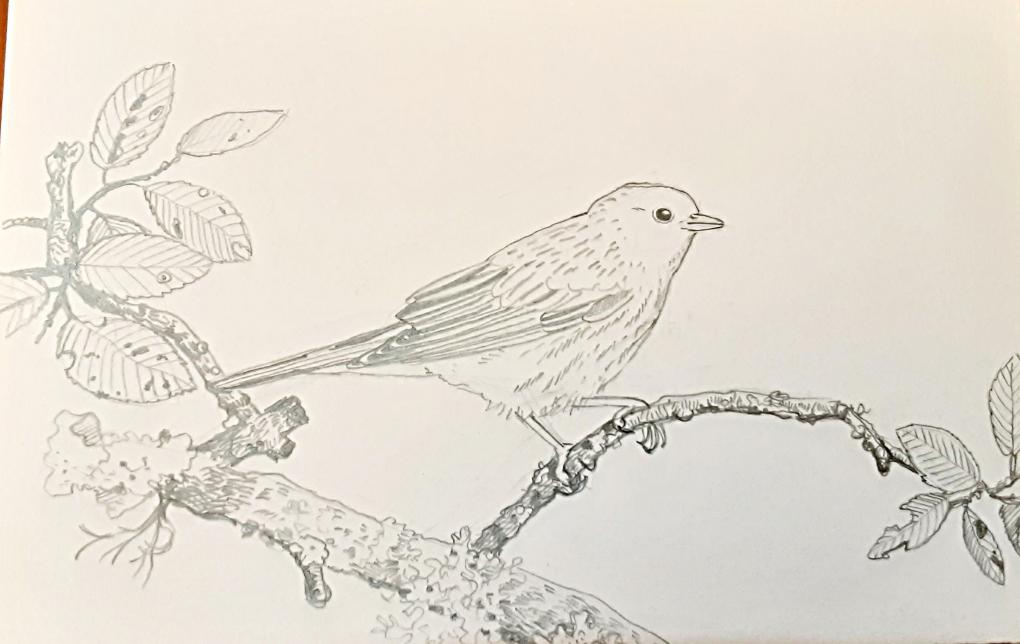
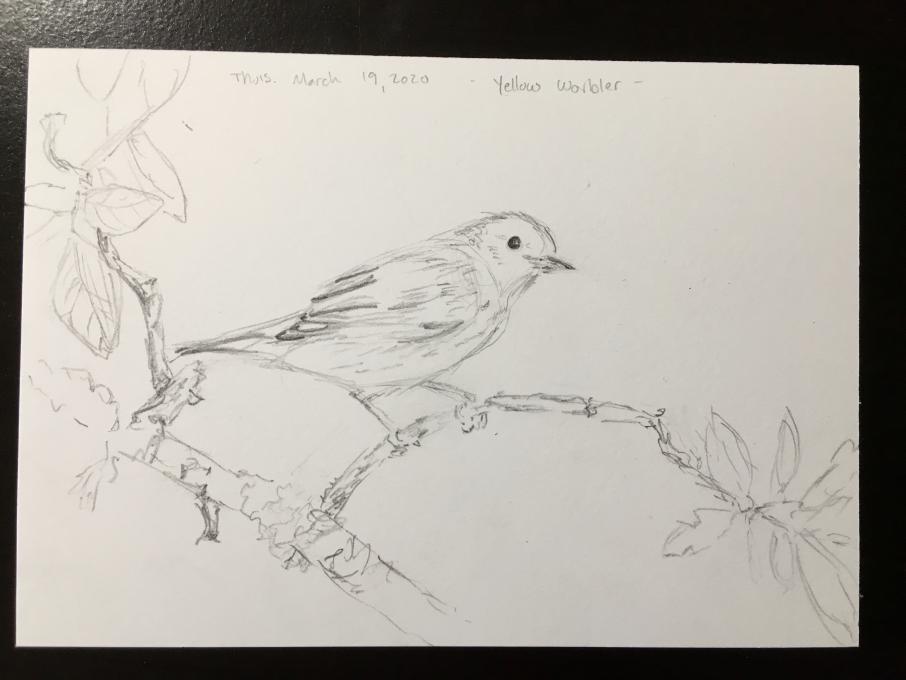
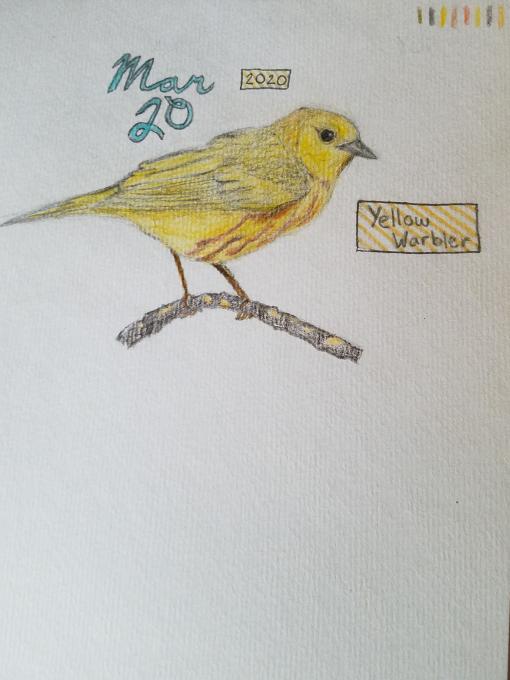
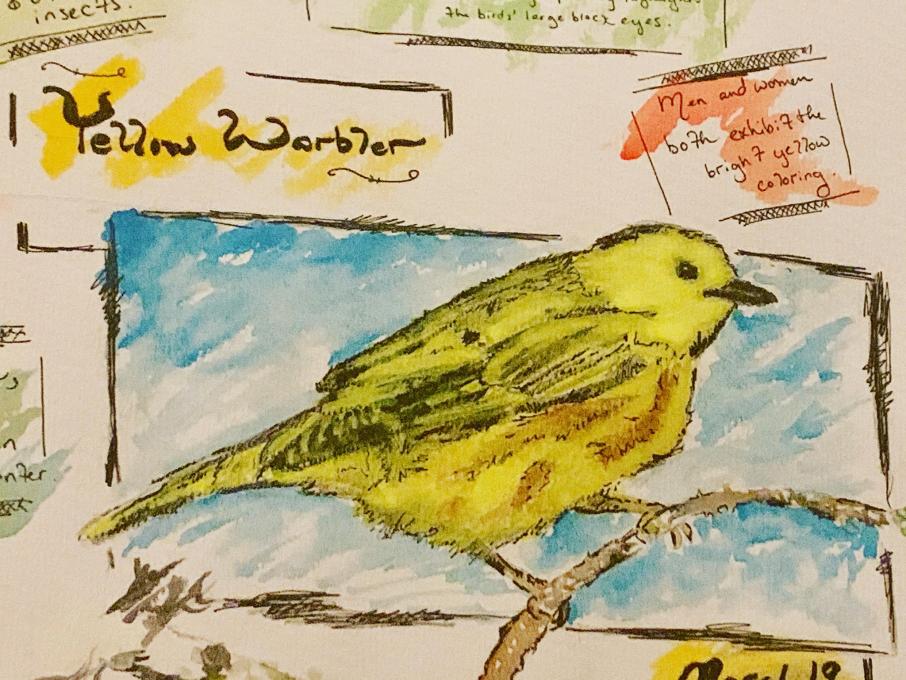
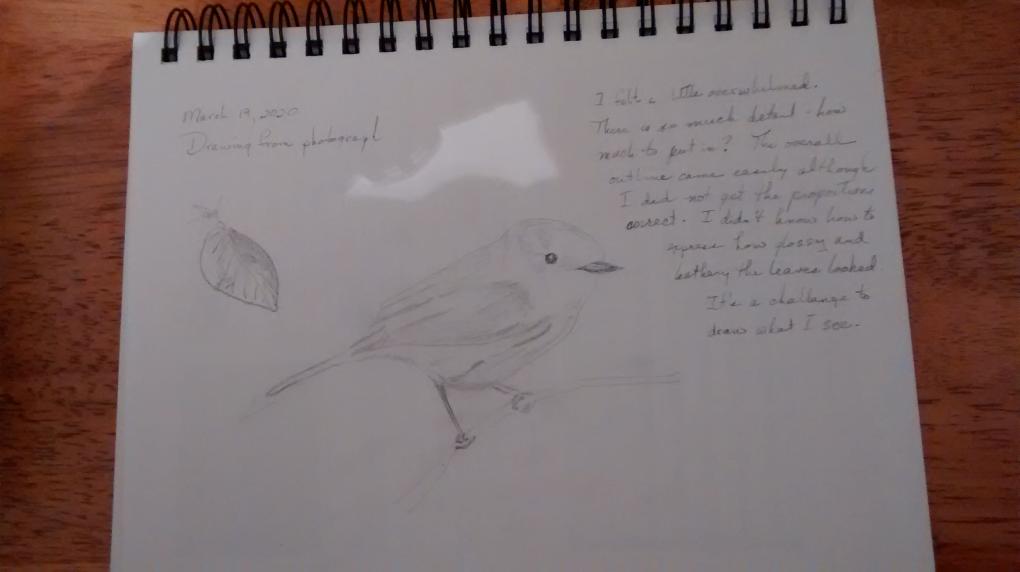
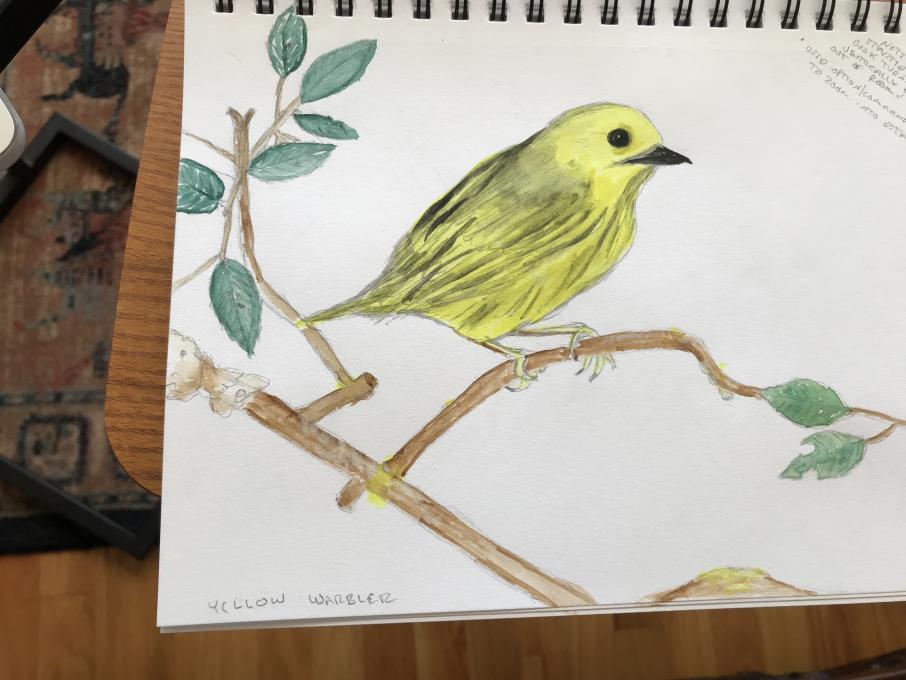
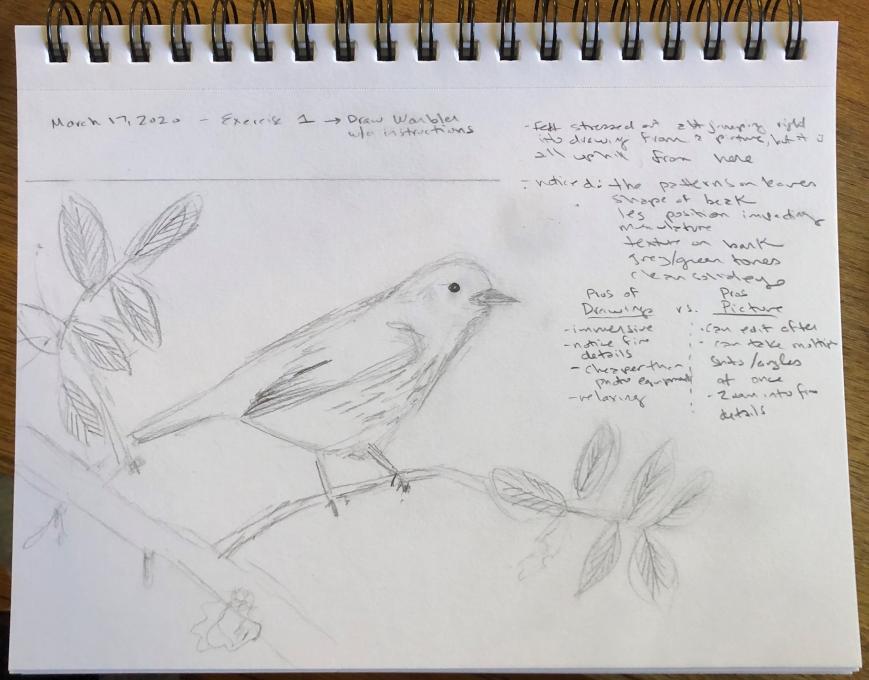
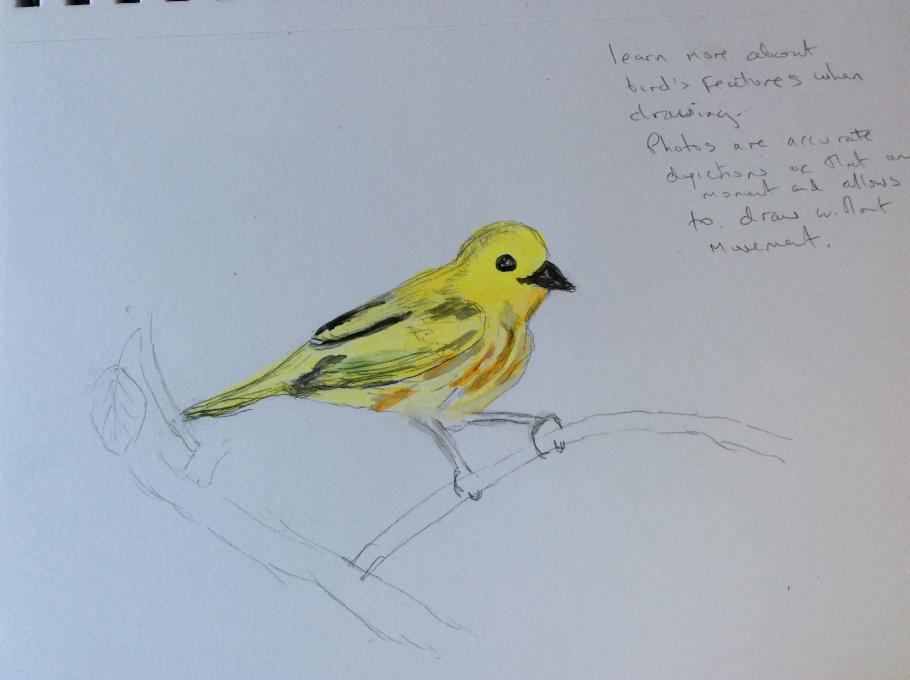
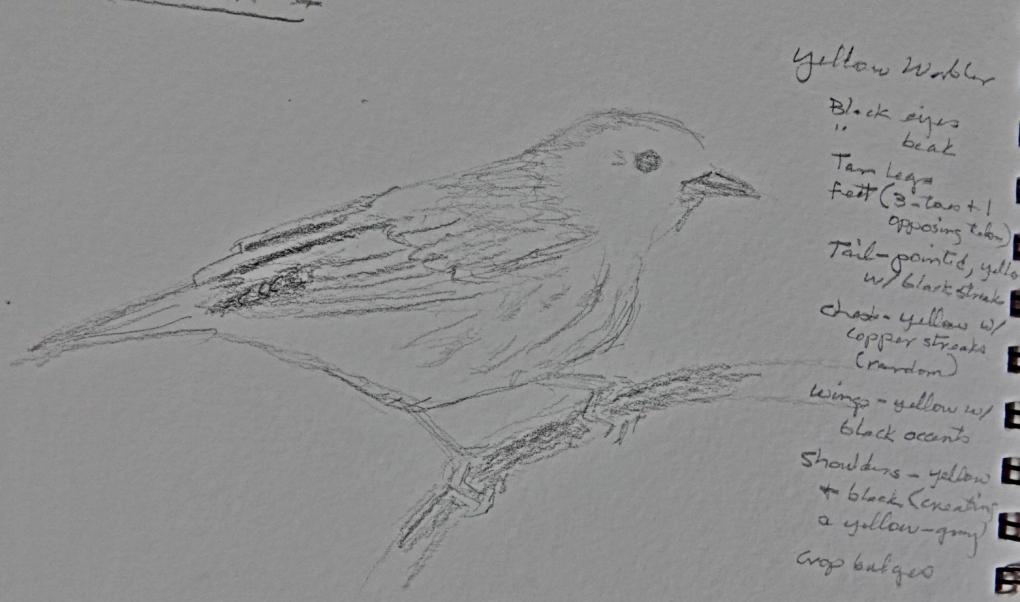
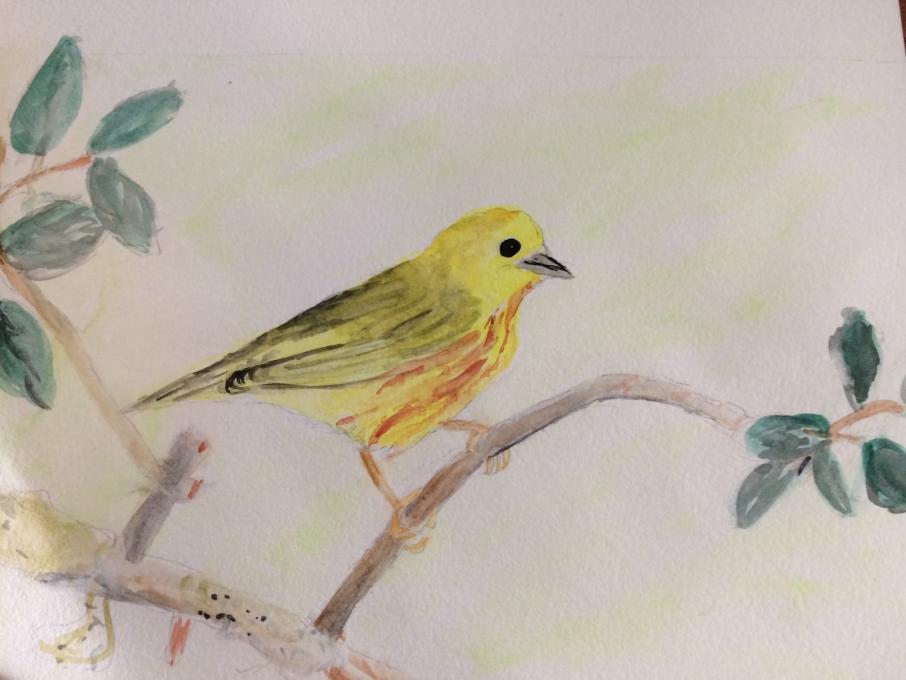 Typically, I draw from photos instead of from real life, which is much harder. I often take photos, just so that I can zoom into what I see, and with birds, have a better chance of identification. While working on this exercise, I found myself more attentive, interestingly enough, to the texture of the feathers and leaves -- as well as the variations of color.
Typically, I draw from photos instead of from real life, which is much harder. I often take photos, just so that I can zoom into what I see, and with birds, have a better chance of identification. While working on this exercise, I found myself more attentive, interestingly enough, to the texture of the feathers and leaves -- as well as the variations of color. 